By Jennie
Some of you may have caught wind of a news story in Canada back in January and February having to do with quinoa and whether its meteoric rise in popularity in wealthy countries over the past 10-15 years is now causing problems for people here in Bolivia (i.e., causing dramatic price increases that were leaving even growers unable to eat it). The media flurry began with an article published in The Guardian newspaper in the UK, followed by copycat pieces on National Public Radio in the US and the Globe and Mail, which ran a headline that said something like The more you love quinoa the more you are hurting farmers in Peru and Bolivia. These very quickly spawned blog posts and impassioned debates about the veracity of their claims and the motives or interests of those who were suggesting that eating quinoa might be unethical and/or defending it. CBC’s The Current aired a 25 minute story called The Great Quinoa Debate; and during one week alone my friend John Cameron (an expert on local governance in Bolivia) was interviewed 16 times on various CBC shows across eastern Canada.
All this was taking place just as we were leaving Canada but enough of it reached my ear to really pique my attention and give me some questions to ask once we got here. (What an amazing opportunity!) So based on what I’ve gleaned, I thought I’d write my own blog post just covering what I’ve learned about the politics and ecology of this grain that has captured so much attention of late. (Oh, did I mention that the UN’s Food and Agriculture Agency had already declared 2013 the International Year of Quinoa?)
So let’s begin with the basics. Quinoa is a pseudo-cereal (‘pseudo’ because it’s not a grass) that was used in the daily diet of the Tiahuanacu and Incan civilizations, the former going back at least 4000 years. There are 17 varieties of quinoa (or ‘quinua’ as it is spelled in Spanish). Some varieties are reddish, some yellow, some green (thus making up the colours of the Bolivian flag!); some are more pink or purple.
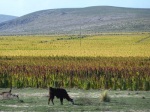 The variety that is exported is Quinua Real (Royal Quinoa in English) and it grows only in the southern Altiplano in Bolivia. (This is the area around and to the south of the Salar de Uyuni.) This is in part due to the grain’s preference for high-altitude conditions; people here say that it doesn’t grow below 3000 metres or above 4000 metres (at least not the good-tasting stuff). In fact, the best stuff, with the biggest grains and most nutrition, grows only between 3700 and 4200 metres. It is well adapted to low oxygen and an arid environment – it thrives on as little as 20 cm of rain a year.
The variety that is exported is Quinua Real (Royal Quinoa in English) and it grows only in the southern Altiplano in Bolivia. (This is the area around and to the south of the Salar de Uyuni.) This is in part due to the grain’s preference for high-altitude conditions; people here say that it doesn’t grow below 3000 metres or above 4000 metres (at least not the good-tasting stuff). In fact, the best stuff, with the biggest grains and most nutrition, grows only between 3700 and 4200 metres. It is well adapted to low oxygen and an arid environment – it thrives on as little as 20 cm of rain a year.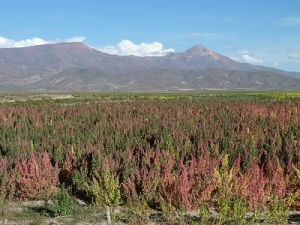
The growing works like this: Villages (pueblos) have a certain amount of land which is held in common and allocated to families according to how much each family can produce; families who can grow more get more land on which to grow. All families work together on the quinoa at seeding and harvest time, with everyone helping on one family’s plot for a week then moving on to another family’s plot the next week. (By the way, my source for much of this information is our driver, Flavio, who took us around the southern Altiplano for three days, and whose family are llama herders in the southern Altiplano.)
Quinoa is planted in late October to November, even up until December 15. It is harvested in April, with the whole plant being pulled up by the roots. In the intervening six months the ground is barren and exposed and very dusty. Even when the quinoa is growing the soil is basically just like sand.
After the rainy season has ended (in April) the quinoa is harvested by hand and spread out to dry on a tarp for about one week. Then the people cover it with another tarp and drive over it until the grains are detached from the husks (they’re actually more flower-like than husk-like but I don’t know a better word). 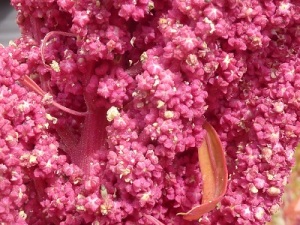 Driving trucks over it is a huge energy-saver compared to doing it by hand as in the past. Then it is winnowed to separate out the grains and picked through by hand to remove any remaining impurities.
Driving trucks over it is a huge energy-saver compared to doing it by hand as in the past. Then it is winnowed to separate out the grains and picked through by hand to remove any remaining impurities.
In the past 10 years, the volume of quinoa being exported from Bolivia has risen from something like 2,000 tonnes/year to about 250,000 and the prices farmers are receiving have increased about 8-10 times. This is the boom that is being called into question by some.
So what are its consequences?
Overwhelmingly, what people here are saying and writing is that this boom has been an extraordinarily good thing for farmers in the southern Altiplano because it is allowing them to move beyond a very meagre subsistence for the first time. In the past, quinoa growers would only live near their crop for about 30-45 days a year and had to go elsewhere and take work (e.g., in the cities) the rest of the time. Now they can afford to stay in their communities, which have been much improved in terms of livability with the addition of electricity, clean water, and access to fruits and vegetables which quinoa farmers can now afford to buy because of their cash incomes. It is important to note that fruits and vegetables do not grow here, so it is not an option to just grow them themselves. Diversifying their diets has improved their families’ health. Quinoa growers are now also able to afford to send their children to school, and buy trucks so they can take their grain to market. The importance of these improvements cannot be understated; the southern Altiplano is one of the areas of the worst child poverty in the country.
According to Flavio, people here understand full well that quinoa is a very nutritious, very important foodstuff. Quinoa growers here are still holding back enough of their crop to meet their own families’ consumption needs; they make it a priority to feed quinoa to their kids.
Even if that were not the case, an important argument being made by the quinoa growers is that they should be free to choose how much quinoa they sell versus how much they keep, and what they do with the money they earn. They have many needs that cannot be met without cash. In this sense, there is a certain paternalism to any argument that suggests that North American and European consumers should try to manage Bolivians’ development and nutritional status by indirectly trying to manipulate Bolivians’ choices by reducing international demand for quinoa. Any calls to boycott quinoa from Bolivia or efforts to replace it with locally grown quinoa (which some people are now trying to grow in Colorado, and also on Vancouver Island) just undermines Bolivian farmers and works against the success they have been trying so hard to achieve and have begun to really benefit from.
Is the rich world quinoa boom causing hunger or malnutrition in the rest of Bolivia?
While people in the southern Altiplano have been eating quinoa for a good long time – along with llama meat – it’s not a national staple, nor has it ever been (Incan times aside, and the Incan empire never included the Amazon basin). The country is so vast, so culturally and geographically diverse, that I think it’s fair to say that in most of the country quinoa is not that commonly eaten, compared to potatoes and maize (the real staples), manioc (in the lowlands), chicken, beef, bananas, rice, and wheat, all of which are produced in Bolivia. (Wheat has been a staple for at least the past 50 years in part because it has been dumped here at below-cost prices by producers in the US often in the form of food “aid”, meaning that the price of wheat was artificially low and domestically grown grains, including quinoa, simply couldn’t compete with it.)
Bolivians also eat other traditional grains, such as cañawa and amaranto, as well as oats, and other types of quinoa which aren’t being exported. Here are some photos of crops that grow in abundance (along with quinoa, potatoes, and maize) in the La Paz-Lake Titicaca area, where the land is wetter and more fertile than in the southern Altiplano (and hence, more suited to a more varied, diverse agriculture).
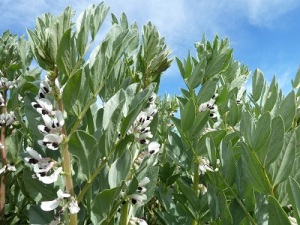
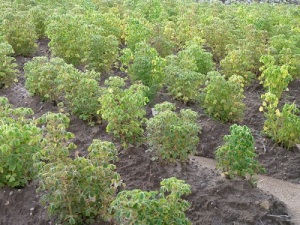
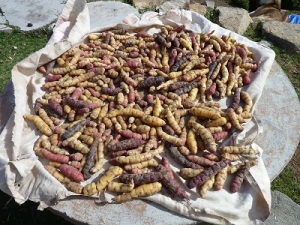 Photos (next page) show a kind of large green bean (sort of like a fava bean) and oca, shown first as it looks above ground, and secondly as it looks post-harvest. I first I thought these were carrots, but they are really more like potatoes.
Photos (next page) show a kind of large green bean (sort of like a fava bean) and oca, shown first as it looks above ground, and secondly as it looks post-harvest. I first I thought these were carrots, but they are really more like potatoes.
If Bolivians are eating less quinoa than they were in the past, this is not necessarily due to increased exports. It is obvious to anyone just travelling through Bolivia as we have been for the past eight weeks, that western foods have high status, that supermarkets (with their expensive, packaged, highly processed and often imported commodities) are “in” for those who can afford to shop at them, and that junk food is everywhere (and cheap!). You can’t turn your head 90 degrees without seeing a Coca-Cola sign or an entire wall painted red in the Coca-Cola logo. Malnutrition has many causes, and the complex factors that lead people in developing countries to abandon traditional healthy foodstuffs in favour of what is being more aggressively marketed and is seen so often on TV cannot be reduced to something as simple as an increased foreign demand for one healthy crop.
It should also be noted that quinoa, coming from the southern Altiplano, is thought of by many people here as a lowly grain, a poor person’s food. When people outside of the southern Altiplano eat quinoa, it tends to be in soup or as a garnish, not as the centrepiece of a meal, at least not for middle-class people who have more options. The Bolivian government is promoting eating quinoa as part of its agenda of elevating indigenous peoples and re-valorizing native traditions, but I sense that this is an uphill battle.
It is important to understand also that export prices and domestic prices for quinoa are different, with domestic prices being far lower. Moreover, in response to the increase in domestic prices and as part of the strategy to use quinoa to enhance nutrition and promote rural development, the Bolivian government has recently announced a revision of prices, which I believe amounts to price controls or consumer subsidies for quinoa to make sure that everyone can afford to buy it. They already have similar policies for cooking oil and sugar. (I saw the announcement on TV on March 8 but didn’t understand enough of the Spanish-language news story to get all the details.)
If anything, the international prominence of quinoa is potentially a boon to efforts to enhance nutrition among Bolivians. It was President Evo Morales who proposed that the UNFAO declare 2013 the International Year of Quinoa, his position being that this is a grain that represents decolonization, self-sufficiency and development for Bolivia. In that sense, the international attention is a good thing and should help the country to take better advantage of its own crop. According to my friend John Cameron (Dalhousie professor and Bolivian local governance expert I referred to in the beginning), this is really a public policy challenge for Bolivians, but a challenge that they are up to handling.
The real problem for Bolivia, John says, is that other countries (including the US, France and Denmark) have started to get in on the game, with some researchers in Colorado actually patenting a strain of quinoa, all of which means that Bolivia could lose its leading position and suffer a real bust after the boom. Here in Bolivia there are hundreds, if not thousands, of people working on the issues of quinoa politics and policy, and they are emphatically arguing “Buy quinoa!” and “Buy quinoa from Bolivia!”
To me, this means that, as much as we might value local food and want to support local agriculture wherever we live, there should be a point at which we ask ourselves whether growing other people’s local foods in our own backyards as an alternative to trading with them is really the ethical choice. In this case, I think it is not. Call it an example of “fair miles” if you will.
Quinoa has been called a “panacea” for rural development.
Another point in favour of quinoa is that it is one of the few income sources in the country that is not derived from either hydrocarbons or mining, and is also legal. No agricultural product besides coca earns as much. (Aside: Much of the country’s coca is being grown for the drug trade and also grown very unsustainably, since the demand is so high that cocaleros will now grow three crops a year, planting the coca plants too close together, using a lot of pesticides and depleting the soil badly. That said, I’m not suggesting that quinoa could replace coca, since they’re grown in very different regions.)
Quinoa can be ecologically sustainable, and in the southern Altiplano it really is not displacing other crops, as it is growing in places where nothing else will grow. In areas around La Paz and Lake Titicaca we saw numerous varieties of quinoa being grown, typically in small patches and/or co-planted with other crops. According to John, most quinoa production, even if not certified, is de facto fair trade and organic. Most of the sale of quinoa is organized and carried out by small-scale producers’ associations, which means that most of the income goes directly to growers. Particularly with exported quinoa, sales are also arranged through contracts, meaning that farmers get a guaranteed price. Finally, quinoa also keeps for a long time, so farmers have the option of waiting until prices are better to sell.
Some drawbacks, risks and limitations
As with any boom, there is a down-side, at least potentially. In this case, it lies in the possibility of social conflict and/or negative environmental consequences if pressures to increase export-oriented production of quinoa become too great.
According to Flavio, there is some pressure coming from at least two directions. First, Evo Morales is ordering local authorities to put more land into quinoa production. Secondly, some people who had gone to the cities in search of work are returning to the countryside and hoping to make a living growing quinoa. Consequently some questions and challenges are arising having to do with property rights, since in the past, the legality of arrangements and boundaries on quinoa-growing lands was unclear. The land in question was just so poor for growing anything else that nobody cared much about title or tenure.
But while it might seem to a foreigner like me driving through the southern Altiplano that there is lots of land available to expand quinoa production, this is not necessarily the case, for several reasons. First, as I mentioned above, the soil is very sandy and nutritionally poor and quinoa only grows in it for about half the year. The rest of the time it is like a dust bowl. Local people do not want all the ground around them barren for six months of every year.
Secondly, ground not planted in quinoa has tola and baja growing on it, which are food for llamas. Llama herders do not want too much land torn up to plant quinoa. Also, the quinoa growers need there to be a lot of llamas around to provide natural fertilizer. Maintaining a balance between quinoa and llamas is important.
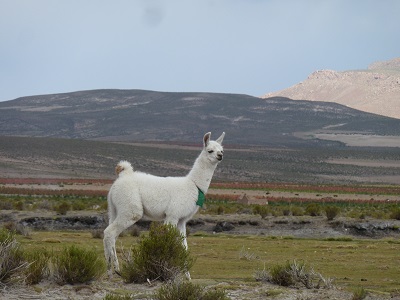 Third, the communities often don’t want to let the urban returnees have land. They know very well that low supply and high demand mean good prices and don’t particularly want to see market forces bring supply and demand into equilibrium. In other words, there is some active supply management going on here.
Third, the communities often don’t want to let the urban returnees have land. They know very well that low supply and high demand mean good prices and don’t particularly want to see market forces bring supply and demand into equilibrium. In other words, there is some active supply management going on here.
The land that belongs to each community extends all the way to the land belonging to the neighbouring community, so there isn’t any land that isn’t already claimed by somebody. Consequently, land allocations appear to be something that have to be worked out on the ground, between communities.
According to John and to some Bolivians I have heard interviewed, social conflicts are being resolved, if not always perfectly (e.g., more successful families are accumulating more income and land, leading to a growing inequality). The point is that Bolivians are working on this and foreigners need to respect that.
Environmentally, the risks have to do with nutrient sustainability and genetic diversity. Right now communities organize their lands such that some are for use in the present and some are being saved for the future. Pressure to utilize more land for growing quinoa now could actually undermine the tradition of leaving some land fallow, which helps ensure that the marginal soils can support this hardy plant over the long term. Similarly, if farmers choose to plant only royal quinoa (the export variety), genetic diversity may be diminished. These environmental concerns are legitimate, but the problems are not yet severe and there are capable, ecologically oriented organizations here in Bolivia that are strongly promoting and supporting organic quinoa production, and educating their members about the importance of ecological practices.
Conclusion
In regards to the debate that has raged in Canada and other wealthy countries about the ethics of eating quinoa, the argument I find most compelling is not found at either pole of the ideological debates that have lately raged about food (i.e., pro and anti-locavore). It is simply an argument for equality and self-determination based on the understanding that quinoa farmers and Bolivians in general are not hapless victims of a food craze gone out of control, but capable actors who, like everyone else, face public policy challenges that they can deal with. It is not up to foreign consumers to step in and try to make policy for them, based on some excessive, misplaced, or paternalistic sense of responsibility.
In saying this, I am not concurring with people like Pierre Desrochers or Doug Saunders, both of whom have used the quinoa debate to argue in sweeping terms for the inherent superiority of imported foods and in favour of unrestricted global trade in food in which comparative [cost] advantage reigns supreme, no matter what the social or ecological cost. Nor am I arguing from a purely defensive position (as one well might, given the almost delirious joy seemingly being taken by some writers at the chance to pull a plank from the presumed self-righteous platform of vegans, “health nuts” and “foodies” in general). I am not a vegan; I am not anti-vegan. What I argue in favour of is food justice with a global conscience: a sensitivity to the importance of human development and self-determination in all places, especially marginalized ones; an awareness of the complex legacies of such historical factors as colonialism and international food “aid” (dumping); and an acceptance of what I believe are probably universal human tendencies, including desires for novelty, variety, and status, as well as pragmatism, all of which can lead people to make less-than-optimum nutritional choices.
One of the many, many writers commenting on this controversy in the Canadian media remarked that the quinoa debate was essentially about the “seeming incompatibility between it fulfilling the UN’s mandate to feed the world’s hungry and becoming a luxury product gobbled up by nutrition-crazed western urbanites”. After talking to people here in Bolivia, I don’t see it that way at all. I think they can indeed have their quinoa and eat it too and that we can be happy to be a part of it.
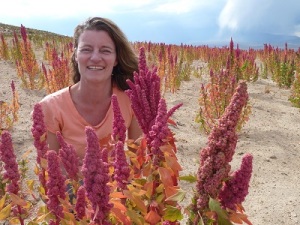
So appreciate getting this perspective from someone on the ground!
So interesting.Jennie you really need to write.How about publishing these blogs.So well written.
Thanks,Penny! We’re home now, but I’ve still got a couple of posts to finish so there’s a bit more coming. Hope you’re well.